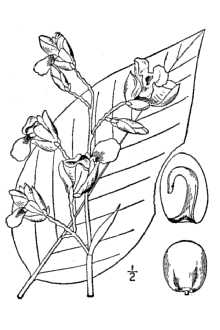Powdery Alligator-flag
Scientific Name: Thalia dealbata Fraser ex Roscoe

| General Information | |
|---|---|
| Usda Symbol | THDE |
| Group | Monocot |
| Life Cycle | Perennial |
| Growth Habits | Forb/herb |
| Native Locations | THDE |
Plant Guide
Use soil moisture sensors to measure the soil moisture of Powdery Alligator-flag.
Fact Sheet
Alternate Names
Other common names: powdery alligator-flag or water canna.
Uses
Powdery thalia is recommended for use in backyard ponds as an aquatic ornamental and constructed wetlands for home septic systems. It may have some benefit as a waterfowl food because ducks will eat the seed.
Status
Powdery thalia is listed as endangered in Illinois. This plant is considered an obligate wetland indicator species. Please consult the PLANTS Web site and your State Department of Natural Resources for this plant’s current status (e.g., threatened or endangered species, state noxious status, and wetland indicator values).
Description and Adaptation
Adaptation
Adaptation
Powdery thalia is a rhizomatous, herbaceous perennial with a bluish, glaucous coating on leaves, flower stalks, and flowers. The 3-4 foot tall leaves arise from the base of the plant with a stout petiole and a large, elongated leaf blade. The attractive purple to bluish flower clusters are produced at the top of a stalk extending 2-3 feet above the foliage. Each fruit consists of a bladdery, paper-like covering loosely surrounding a single seed. The seed are round to oval and dark brown speckled with tan when mature. Flowers are produced from late May to September with fruit maturing throughout the summer. There are about 1275 seeds per pound. Powdery thalia is usually found growing in wet ditches and along the margins of ponds on sites where the soil often contains a high level of organic matter. The nutrient loading capacity for sewage effluent has not been determined; however, powdery thalia will tolerate those levels normally found in a single residence septic system. It can tolerate water depths up to 1.5 feet during the growing season with deeper flooding tolerated during the dormant season. The species occurs in the Coastal Plain from South Carolina to Texas and also in Oklahoma and Missouri. Powdery thalia distribution from USDA-NRCS PLANTS Database. For updated distribution, please consult the Plant Profile page for this species on the PLANTS Web site.
Establishment
To ensure survival in a wetland site, vegetative propagules are required, Planting can be done throughout the year in the southeastern states, Planting pieces should consist of a 4-6 inch section of rhizome with several growing points, If the plants are actively growing, the shoots should not be cut shorter than 6-8 inches, A two-foot spacing will allow the plants to easily fill in the planting area in one growing season, The planting hole should allow for the length of the rhizome and should be deep enough for one inch of soil to cover the top of the rhizome, Water levels should be kept at about 1-2 inches until the plants become established and should never be allowed to cover the entire shoot of non-dormant plants, In a constructed wetland, sewage effluent should not be introduced into the water until the plants become established, Although seedlings rarely establish naturally in most wetland situations, seedlings can be produced easily indoors, Seed collection should be delayed until the majority of the fruit in the cluster has turned brown, because immature fruit will fall from the cluster along with ripe ones when the cluster is shaken to remove the fruit, It is not necessary to remove the fruit coverings before sowing, but this is easily done by rubbing, The seed can be stored dry, but should be placed in a moist medium and stored in the refrigerator for three months before sowing, The growing medium must be kept moist, but not saturated and air temperatures should be at least 75°F, The seedlings can be planted in the wetland when they are approximately one foot tall, Use soil moisture sensors to measure the soil moisture of Powdery Alligator-flag.,
Management
During the dormant season, old flower stalks and dead foliage can be removed, but it is a good idea to leave a long enough section of the leaf petiole so the cut end remains above the water level.
Pests and Potential Problems
Some minor, mainly aesthetic damage by leaf rolling insects has been noted.
Environmental Concerns
Light applications of a complete fertilizer will improve growth throughout the growing season, but care should be taken to prevent fertilizer movement into the ground water. In a constructed wetland, the levels of nutrients applied in the sewage may be sufficient to maintain acceptable growth. Cultivars, Improved, and Selected Materials (and area of origin) Indian Bayou Source powdery thalia was originally collected in the delta area of Mississippi was released as source identified material in 1996 by the Natural Resources Conservation Service (NRCS), the Mississippi Agricultural and Forestry Experiment Station (MAFES), and the Department of Wildlife and Fisheries at Mississippi State University.
Prepared By
Thomas C. Moss, USDA NRCS Jamie L. Whitten Plant Materials Center, Coffeeville, MS
